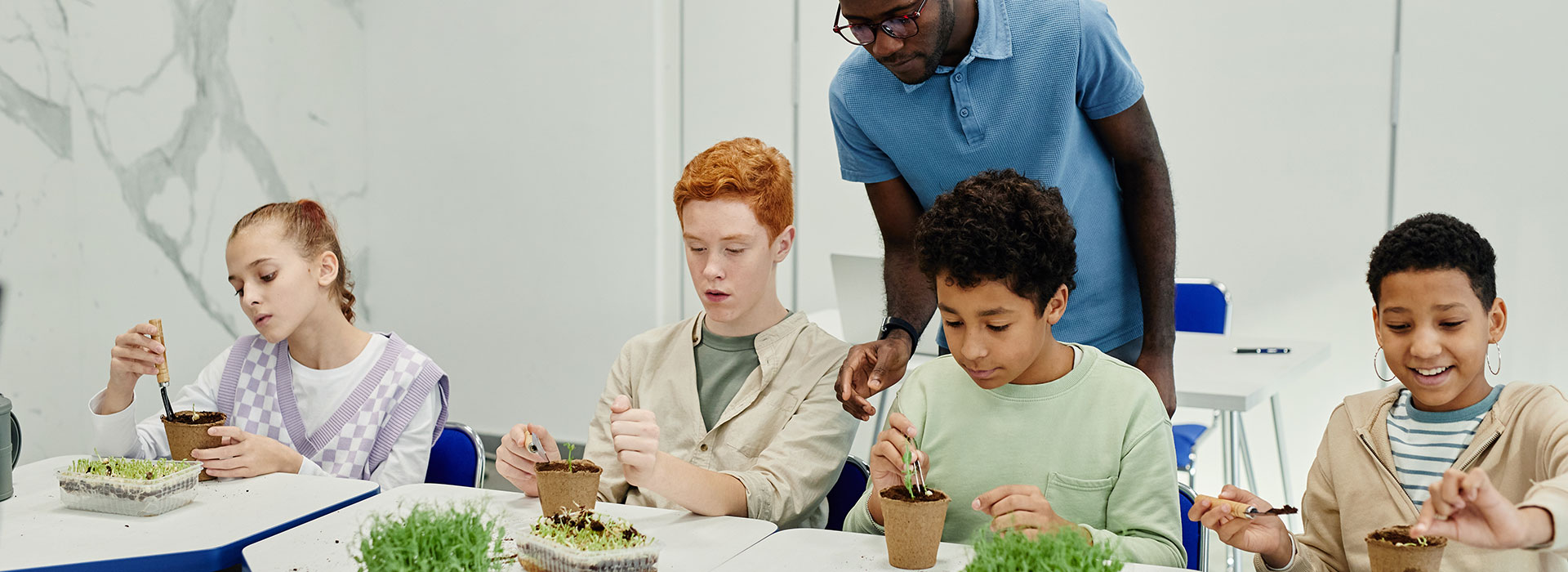5 Steps to Introduce SPBL Into Your Curriculum
As a parent, I struggle to get my kids to eat fruits and vegetables as often as they should. I know that many parents have mastered this art, I have not.
What I have found is that my kids will drink smoothies. They like smoothies with zero sugar vanilla Greek yogurt, strawberries, bananas, and protein powder. Maybe someday I will sneak in some kale just to see what happens. The truth is that having all of these healthy foods blended together makes it more practical and less overwhelming for them to eat healthier. They are much more likely to drink a smoothie than they are to eat a plate of bananas, strawberries, and a full cup of Greek yogurt.
This same idea of making things more practical and less overwhelming can be applied to the 5 Step Process of Sustainable Project-Based Learning.

Today, in schools educators have a lot on their plate in addition to all of the adjustments made for teaching through the pandemic. Initiatives on their plate include:
- Participating in Professional Learning Communities (PLCs).
- Supporting students with their social and emotional well-being.
- Implementing best practices in Unit and lesson design.
- Considering best practices in assessment.
- Participating in Multi-Tiered System of Support interventions.
- Incorporating high-impact strategies (such as John Hattie’s Visible Learning Influences).
- Ensuring students are either reading, writing, speaking, or listening on a daily basis.
Just like that full plate of bananas, strawberries, Greek yogurt, protein, and kale (again I have not tried this yet, but it is a goal), the 5 Steps of Sustainable Project-Based Learning create a process that encompasses multiple initiatives into one framework.
The 5 Steps for Sustainable Project-Based Learning (SPBL)
Step 1: Planning the SPBL Unit
Think “Understanding by Design” meets John Hattie’s “High-impact strategies” all in a 1-page planning template that also incorporates clarity around clear Social-Emotional Learning (SEL) Skills. The template includes:
- Academic standards.
- Learning intentions based on academic standards and clear CASEL SEL skills.
- Success criteria.
- A driving question.
- Tasks at the surface, deep, and transfer levels of learning.
Step 2: Plan the SPBL Assessment
When it comes to assessments within the SPBL unit, Sustainable Project-Based Learning ensures that the assessments are focused on both students understanding the academic standards and content as well as a clear SEL or employability skill. Sustainable Project-Based Learning is all about ensuring that students have an equal understanding of surface, deep, and transfer level knowledge in both content and skills. Therefore, formative and summative assessments are all focused on this concept.
- A culminating product rubric.
- A clear and practical template for a formative assessment calendar.
- A clear and practical template for concrete benchmarks and milestones during the SPBL unit.
Step 3: Establish a Clear Goal for Student Learning with your PLC Team
Just like effective PLC teams establish a clear goal around student learning and work towards that goal, it is also done in a practical way among teacher collaboration teams within the SPBL.
Too often, teachers get trained on PBL, they learn how to design a PBL unit, they leave the training excited, energized, and ready to implement. However, planning the unit is really the first step. In order to sustain project-based learning, we need to be intentional about the conversations we have during teacher collaboration time before, during, and after the implementation of the PBL unit.
Personally, I like using the SMART goal format to craft a goal that is centered around growth in student learning during the unit. The goal should focus on the evidence of learning produced from the SPBL formative assessments (created in step 2). Since the assessments were all grounded in measuring student understanding of surface, deep, and transfer levels of learning, the SMART goal should be grounded in this language as well.
In order to make the SMART goal that much more powerful, teacher teams should commit to using some protocols to ensure equitable and focused conversations during PLC team meetings. For example, using a What? So What? Now What? Protocol while examining a student formative assessment or milestone from the SPBL unit. Or perhaps your team wants to get into one another’s classroom and do a focused observation. In that case, the Observer as a Learner Protocol might be a good one to implement.
Step 4: Conducting Teacher Action Research
Now that the SMART goal is created, conducting teacher action research is simply carrying out the implementation of that SMART Goal with just one additional layer of focus, the SPBL Action Research questions:
- How do you ensure at least one year’s growth in one year’s time?
- How do you ensure an equal intensity of surface-, deep-, and transfer-level learning for each unit of study?
- How do you define and provide intentional feedback to students on their growth in both content knowledge and SEL skills?
No matter what the goal or protocol, these three questions are the foundation of sustaining PBL. They ensure accountability that the focus is always on the evidence and growth of learning, and not on how aesthetically pleasing the product looks.
Being Mindful of Equity during Teacher Action Research
While conducting the Teacher Action Research and carrying out the SMART goal established in “Courageous Conversations About Race,” Singleton and Linton (2005) state there are four agreements of courageous conversations:
Stay engaged
“Participants are not allowed to “check out” of the conversation. They must remain morally, emotionally, intellectually, and socially involved in the dialogue” (p. 59).
Experience discomfort
“Participants need to be willing to engage in dialogue authentically. Participants need to be personally responsible for pushing themselves which might make them uncomfortable but lead to real growth” (p. 63).
Speak your truth
“Be absolutely honest about the thoughts, feelings, and opinions that you have. You should not just say what you think people want to hear” (p. 60).
Expect and accept non-closure
“The solution is revealed in the process of dialogue itself.”
Issues of racial equity are complex. ‘If people expect and accept non-closure in racial discourse, then the more they talk, the more they learn; and the more they learn, the more appropriate and promising will be their actions and interventions’” (p. 65).
You and your team members can apply these four agreements when meeting throughout the
SPBL process to discuss your action research. These norms or agreements are especially important because teacher action research in SPBL can prove to be an opportunity to lean into equity for students, equity in participation and conversations should also be modeled among teachers.
Step 5: Reflecting, Refining, and Celebrating
For this final step, you can use the following checklist:
Reflect
Ask yourself and your team the following questions:
- Were the three SPBL questions answered? Why or why not?
Refine
Ask yourself and your team the following questions:
- Did you use the data gleaned from the student assessments and your experiences to refine the process so students grow in their assessment capability and ownership of learning?
- Did you use the data gleaned from student assessments and your experiences to refine the process so you have more ownership in the planning of the SPBL unit and the action research goal setting and implementation process? (ex. Consider having students co-construct success criteria, and driving questions. Consider planning an interdisciplinary SPBL unit).
- How might I incorporate more high-impact strategies within the context of the SPBL unit?
Celebrate
With students:
- At some point in the SPBL unit, gather feedback from students regarding how they like to celebrate (snacks, music, and so on).
- After students complete the culminating public product, encourage students to celebrate the success of their learning.
- Create opportunities for students to affirm one another.
With your team:
- Find ways to give kind and specific affirmation to each member of the team.
- Honor and recognize how the work was challenging but rewarding.
The 5 step process will not only help to sustain project-based learning, but it will also ensure that the focus will always be on the evidence of learning before, during, and after PBL implementation. And just like how a smoothie blends together multiple healthy foods, this 5 step process blends together aspects of SEL, PBL, PLCs, conversations around equity, and research-based high-impact strategies.
If you are interested in learning more and would like to see examples and templates to assist with these 5 steps, check out my book Sustainable Project-Based Learning: Five Steps for Designing Authentic Classroom Experiences in Grades 5-12 (An instructional framework for developing ongoing project-based learning tasks and units)
References:
Singleton, G. E., & Linton, C. (2022). Courageous conversations about race: A field guide for achieving equity in schools. Thousand Oaks, CA: Corwin Press.


